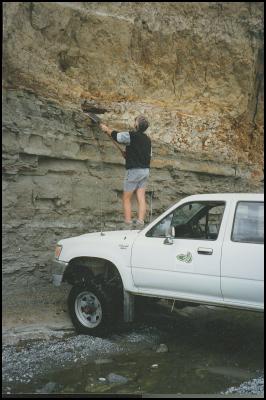Time capsule helps predict climate change
East Coast time capsule helps predict climate
change effects

Landcare Research geomorphologists led by Dr Mike Marden and colleagues from Massey University are undertaking their research in the Gisborne district’s Waipaoa catchment. It is one of two key sites in the world chosen by the international science community for studying potential climate change impacts.
Because Waipaoa is sited on the margin of a continental plate, it is of particular interest to similarly situated areas such as Japan and the western coasts of North and South America.
Clues to the effects of past storms can be found on the hills and in sediment along the Waipaoa valley. Typically, volcanic ash, wood and pollen are preserved within these sediments and can be used to date particular events.
Researchers from universities in California, Indiana and Kentucky are meanwhile studying the sediment in cores taken from the ocean floor off Poverty Bay. These oceanographic records will eventually be correlated with Landcare Research’s land-based records to reconstruct a chronology of landscape adjustment over thousands of years.
“Current knowledge tells us that with the increased rainfall and prolonged periods of high soil moisture expected as our climate changes, Waipaoa’s hill country will increasingly fail,” Dr Marden says.
“Based on new knowledge of past events, we will be able to identify which parts of the landscape are stressed and most likely to be vulnerable to the effects of future storms.
“Our findings will have significant implications not just for the Waipaoa catchment, but nationally and internationally.”
ENDS


 Greenpeace: Greenpeace Calls On Fonterra Investors To Consider Big Picture With Giant Puzzle
Greenpeace: Greenpeace Calls On Fonterra Investors To Consider Big Picture With Giant Puzzle Hugh Grant: How New Tech Helps Kids Love Soccer More
Hugh Grant: How New Tech Helps Kids Love Soccer More Bill Bennett: Download Weekly - 100% claim lands One New Zealand in criminal court action
Bill Bennett: Download Weekly - 100% claim lands One New Zealand in criminal court action FSCL: Woman Scammed Out Of $25,000 After Job Offer On LinkedIn
FSCL: Woman Scammed Out Of $25,000 After Job Offer On LinkedIn NIWA: Cheers To Crustaceans - New Species Named After Welly Brewery
NIWA: Cheers To Crustaceans - New Species Named After Welly Brewery MBIE: Trans-Tasman Earth Observation Research Studies Confirmed
MBIE: Trans-Tasman Earth Observation Research Studies Confirmed



